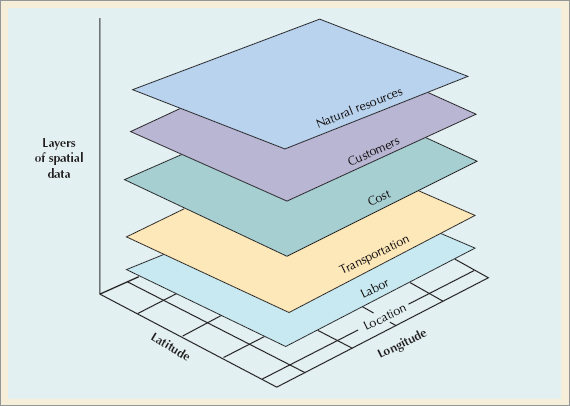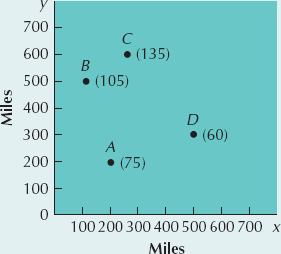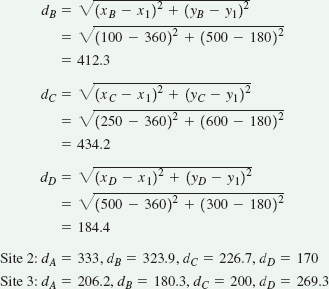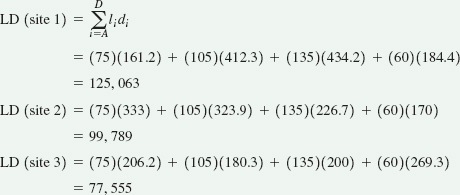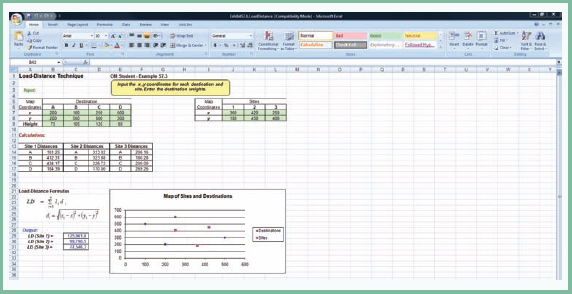In this supplement, you will learn about . . .
The physical location of business facilities can have a significant impact on the success of a company. In this supplement we will briefly discuss some of the factors that are impor-tant in locating facilities. We will focus on several quantitative methods for facility location, including location factor ratings, the center-of-gravity technique, and the load-distance technique.
The type of facility is a major determinant of its location. The factors important in determining the location of a manufacturing plant are usually different from those important in locating a service facility or a warehouse. In this section we discuss the major categories of facilities and the different factors that are important in the location desired.
Heavy manufacturing facilities are plants that are large, require a lot of space, and are expensive to construct, such as automobile plants, steel mills, and oil refineries.
Factors in the location decision for plants include construction costs, land costs, modes of transportation for shipping heavy manufactured items and receiving bulk shipments of raw materials, proximity to raw materials, utilities, means of waste disposal, and labor availability. Sites for manufacturing plants are normally selected where construction and land costs can be kept at a minimum and raw material sources are nearby in order to reduce transportation costs. Access to railroads is frequently a factor in locating a plant. Environmental issues have increasingly become a factor in plant location decisions.
Heavy-manufacturing facilities are large, require a lot of space, and are expensive.
Light-industry facilities are smaller, cleaner plants and are usually less costly.
Light-industry facilities are perceived as cleaner plants that produce electronic equipment and components, computer products, or assembled products like TVs; breweries; or pharmaceutical firms.
Distribution centers for The Gap in Gallatin, Tennessee, Target in Augusta City, Virginia, and Home Depot in Savannah, Georgia, each encompass more than 1.4 million square feet of space— about 30 times bigger than the area of a football field! The UPS Worldwide Logistics warehouse in Louisville, Kentucky, includes 1.3 million square feet of floor space. Because of their role as intermediate points in the supply chain, transportation costs are often an important factor in the location decision for warehouses. The proximity to markets is also a consideration, depending on the delivery requirements, including frequency of delivery required by the customer.
Retail and service facilities are the smallest and least costly.
Retail and service facilities are usually the smallest and least costly. Examples include retail facilities such as groceries and department stores, among many others, and such service facilities as restaurants, banks, hotels, cleaners, clinics, and law offices. However, there are always exceptions, and some service facilities, such as a hospital, a company headquarters, a resort hotel, or a university academic building can be large and expensive. One of the most important factors for locating a service or retail facility is proximity to customers. It is often critical that a service facility be near the customers it serves, and a retail facility must be near the customers who buy from it. Construction costs tend to be less important, although land or leasing costs can be high. For retail operations, for which the saying "location is everything" is meaningful, site costs can be very high. Factors like zoning, utilities, transportation, environmental constraints, and labor tend to be less important for service operations, and closeness to suppliers is not usually as important as it is to manufacturing firms, which must be close to materials and parts suppliers.
When we see in the news that a company has selected a site for a new plant, or a new store is opening, the announcement can appear trivial. Usually it is reported that a particular site was selected from among two or three alternatives, and a few reasons are provided, such as good community, heavy customer traffic, or available land. However, such media reports do not reveal the long, detailed process for selecting a site for a business facility. It is usually the culmination of a selection process that can take several years and the evaluation of dozens or hundreds of potential sites.
Decisions regarding where to locate a business facility or plant are not made frequently, but they tend to be crucial in terms of a firm's profitability and long-term survival. A mistake in location is not easily overcome. Business success often is being "in the right place at the right time." For a service operation such as a restaurant, hotel, or retail store, being in the right place usually means in a location that is convenient and easily accessible to customers.
Location decisions for services tend to be an important part of the overall market strategy for the delivery of their products or services to customers. However, a business cannot simply survey the demographic characteristics of a geographic area and build a facility at the location with the greatest potential for customer traffic; other factors, particularly financial considerations, must be part of the location decision. Obviously, a site on Fifth Avenue in New York City would be attractive for a McDonald's restaurant, but can enough hamburgers and french fries be sold to pay the rent? In this case, the answer is yes.
Location decisions are usually made more frequently for service operations than manufacturing facilities. Facilities for service-related businesses tend to be smaller and less costly, although a hospital, or hotel can require a huge investment and be very large. Services depend on a certain degree of market saturation; the location is actually part of their product. Where to locate a manu-facturing facility is also important, but for different reasons, not the least of which is the very high expense of building a plant or factory. Although the primary location criteria for a service-related business is usually access to customers, a different set of criteria is important for a manufacturing facility. These include the nature of the labor force, and labor costs, proximity to suppliers and markets, distribution and transportation costs, energy availability and cost, the community infra-structure of roads, sewers, and utilities, quality of life in a community, and government regulations and taxes.
When the site selection process is initiated, the pool of potential locations for a manufacturing or service facility is, literally, global. In today's international marketplace, countries around the world become potential sites. The site selection process is one of gradually and methodically narrowing down the pool of alternatives until the final location is determined. In the following discussion, we identify some of the factors that companies consider when determining the country, region, community, and site at which to locate a facility.
In recent years U.S. companies have begun to locate in foreign countries to be closer to newly emerging markets and to take advantage of lower labor costs. Trade agreements between countries have reduced trade barriers around the world and created new markets like the European Community (EC), Eastern Europe, and Asia.
Foreign firms have also begun to locate in the United States to be closer to their customers. For both U.S. and foreign companies, the motivation is the same—to reduce supply chain costs and better serve their customers. Relatively slow overseas transportation requires multinational companies to maintain large, costly inventories to serve their foreign customers in a timely manner. This drives up supply chain costs and makes it economical for companies to relocate closer to their markets.
While foreign markets offer great opportunities, the problems with locating in a foreign country can be substantial, making site location a very important part of supply chain design. For example, although China offers an extremely attractive market because of its huge population, growing econ-omy, and cheap labor force, it has an inefficient transportation and distribution system, and numerous government regulations. Markets in Russia and the former Soviet states are attractive; however they can also be risky since the free market economy is still new to these states. Lack of familiarity with standard business practices and corruption can threaten success for foreign companies.
Some of the factors that multinational firms must consider when locating in a foreign country include the following:
Government stability
Government regulations
Political and economic systems
Economic stability and growth
Exchange rates
Culture
Climate
Export and import regulations, duties, and tariffs
Raw material availability
Number and proximity of suppliers
Transportation and distribution systems
Labor force cost and education
Available technology
Commercial travel
Technical expertise
Cross-border trade regulations
Group trade agreements
Manufacturing facilities in the United States were historically located in the Midwest, especially in the Great Lakes region. Industry migrated to the sunbelt areas, the Southeast and Southwest, during the 1960s and 1970s, where labor was cheaper (and not unionized), the climate was better, and the economy was growing. However, in the late 1990s, there was a perceptible shift in new plants and plant expansion back to the nation's agricultural heartland. The North Central region, consisting of Illinois, Michigan, and Ohio, attracted new and expanded facilities as did the South Atlantic region.
The most growth in manufacturing facilities is in the Midwest.
Certain states are successful in attracting new manufacturing facilities for a variety of reasons. Ohio, for example, is well located along the Interstate-75 corridor, and it is within one-day truck delivery of 60% of the U.S. population and two-thirds of its purchasing power. It has a good base of skilled and educated labor, a large mass of industry that spawns other businesses, and it has established good incentive programs to attract new businesses. Ohio also benefits from a number of towns and cities with populations less than 50,000 that have a rich agricultural heritage. The residents of these communities have a strong work ethic and are self-reliant and neighborly. These communities typically have quality health services; low crime rates; solid infrastructures of roads, water and sewer systems; open spaces to expand; and quality education.
Ohio attracts manufacturing facilities because of good transportation, skilled labor with a strong work ethic, incentive programs, and quality social services.
Labor is one of the most important factors in a location decision, including the cost of labor, availability, work ethic, the presence of organized labor and labor conflict, and skill and educational level. Traditionally, labor costs have been lower and organized labor has been less visible across the South and Southwest. While labor conflict is anathema to many companies, in some cases labor unions have assisted in attracting new plants or in keeping existing plants from relocating by making attractive concessions.
Labor—cost, availability, work ethic, conflict, and skill—is important in a company's location decision.
The proximity of suppliers and markets are important location factors. Manufacturing companies need to be close to materials, and service companies like fast-food restaurants, retail stores, groceries, and service stations need to be close to customers and distribution centers. Transporta-tion costs can be significant if frequent deliveries over long distances are required. The closeness of suppliers can determine the amount of inventory a company must keep on hand and how quickly it can serve its own customers. Uncertainty in delivery schedules from suppliers can require excessive inventories.
Closeness to customers can be a factor in providing quality service.
It is important for service-related businesses to be located near their customers. Many businesses simply look for a high volume of customer traffic as the main determinant of location, regardless of the competition. An interstate highway exit onto a major thoroughfare always has a number of competing service stations and fast-food restaurants. Shopping malls are an example of a location in which a critical mass of customer traffic is sought to support a variety of similar and dissimilar businesses.
Service facilities generally require high customer-traffic volume.
Another important factor, infrastructure, is the collection of physical support systems of a location, including the roads, water and sewer, and utilities. If a community does not have a good infrastructure, it must make improvements if it hopes to attract new business facilities. From a company's perspective, an inadequate infrastructure will add to its supply chain costs and inhibit its customer service.
•Infrastructure: the roads, water and sewer, and utilities at a location.
Factors that are considered when selecting the part of the country and community for a facility are summarized as follows:
Labor (availability, education, cost, and unions)
Proximity of customers
Number of customers
Construction/leasing costs
Land cost
Modes and quality of transportation
Transportation costs
Community government
Local business regulations
Government services (e.g., Chamber of Commerce)
Financial services
Community inducements
Business climate
Community services
Incentive packages
Government regulations
Environmental regulations
Raw material availability
Commercial travel
Climate
Infrastructure (e.g., roads, water, sewers)
Quality of life
Taxes
Availability of sites
Proximity of suppliers
Education system
Besides physical and societal characteristics, local incentives have increasingly become a major important factor in attracting companies to specific locations. Incentive packages typically include job tax credits, relaxed government regulations, job training, road and sewage infrastructure improvements, and sometimes just plain cash. These incentives plus the advantages of a superior location can significantly reduce a company's supply chain costs while helping it achieve its strategic goal for customer service.
Location incentives include tax credits, relaxed government regulations, job training, infrastructure improvements, and money.
States and communities cannot afford to overlook incentives if they hope to attract new companies and jobs. However, they must make sure that the amount of their investment in incentive packages and the costs they incur for infrastructure improvements are balanced against the number of new jobs developed and the expansion of the economy the new plant will provide. Incentives are a good public investment unless they bankrupt the locality. While some small communities are successful in attracting new businesses, they are left with little remaining tax base to pay for the infrastructure improvements needed to support the increased population drawn by job demand. Thus, states and communities, much like businesses, need a strategy for economic development that weighs the costs versus the benefits of attracting companies.
A recent information technological advancement that is increasingly being used in the facility location and site selection process is a geographic information system or GIS. A GIS is a computerized system for storing, managing, creating, analyzing, integrating, and digitally displaying geographic (i.e., spatial, data). A GIS is both a database system as well as a set of operations for working with and analyzing this data. As a tool specifically used for site selection, it allows the user to interactively search and analyze the type of data and information (i.e., location factors) we discussed in the previous sections that might be related to the site selection process, such as population, labor, income, customer base, climate, taxes, and transportation. Frequently a GIS used for site selection will incorporate quantitative models (like the ones presented later in this chapter and text) to help analyze the data.
Figure S7.1 provides a simple schematic diagram of how a GIS for site selection might be constructed. Each layer (or spatial map) in this diagram contains information about one characteristic (or attribute) of the location begin analyzed. Each layer that might relate to the site selection process is precisely overlaid on the other layers so that their corresponding geographic (spatial, locations) are exactly matched to each other. The bottom layer is a geographic grid that serves as a frame of reference (e.g., latitude and longitude), to which all the other layers are precisely matched.
Once these layers of data have been entered into the GIS, information about the layers can be compared and analyzed in combination. For example, transportation routes can be considered relative to the location of plants, distribution centers, and shippers, as well as labor markets and natural resources, such as water. Such comparative analyses are frequently in the form of digital computer displays as well as three-dimensional graphs and displays. The GIS may provide just statistical analyses for use in the decision-making process, or it may incorporate one or more quantitative models to provide a recommended decision about a site.
The advantage of a GIS is that it enables the user to integrate large quantities of information about potential facility sites and then analyze these data with a number of different, powerful analytical tools. The ability to consider hundreds of separate layers of spatial information and then combine it with other layers of information is the main reason GIS has become such a popular tool for location analysis and site selection.
One of the first major uses of GIS was in environmental and natural resources planning, and land use management for the analysis of such things as agricultural lands, wildlife habitat, wetlands, floodplains, and forests. It has also come to be used extensively for utilities and infrastructure planning and management, including such things as energy use, cable and pipe networks, gas lines, electrical usage and networks, and transportation, as well as real estate analysis, demographic and marketing analysis, and various government applications such as emergency services and analyzing tax bases. However, in recent years GIS has come to be used more and more in business applications. For example, GIS has been used to select distribution centers or hubs based on spatial data for shipping times, customer locations, transportation routes, etc. Bank of America upon entering the New York City market used a GIS to show the distribution of its own branch network relative to deposit potential in the New York market area; from this they determined where their market coverage was strong or weak. Levi Strauss used a GIS to create a geographic network of its existing retailers, potential retailers, and the customer base each served, so it could make sure that new stores that joined its retail network would not adversely affect sales in existing stores. Edens & Avant, one of the nation's leading retail real estate companies, has a GIS-based Web site that enables retailers to locate space in their inventory (at various shopping malls, etc.) that specifically matches their site selection criteria.
Today there are hundreds of commercial software systems that offer GIS capabilities for different applications including site selection, and numerous consulting and software firms that specialize in the development of GIS for specific applications. The list of Web sites for this supplement includes links to several GIS software systems and some of the major companies that specialize in GIS development and applications.
We will discuss three techniques to help make a location decision—the location rating factor, the center-of-gravity technique, and the load-distance technique. The location factor rating mathematically evaluates location factors, such as those identified in the previous section. The center-of-gravity and load-distance techniques are quantitative models that centrally locate a proposed facility among existing facilities.
The decision where to locate is based on many different types of information and inputs. There is no single model or technique that will select the "best" site from a group. However, techniques are available that help to organize site information and that can be used as a starting point for comparing different locations.
•Location factor rating: a method for identifying and weighting important location factors.
In the location factor rating system, factors that are important in the location decision are identified. Each factor is weighted from 0 to 1.00 to prioritize the factor and reflect its importance. A subjective score is assigned (usually between 0 and 100) to each factor based on its attractiveness compared with other locations, and the weighted scores are summed. Decisions typically will not be made based solely on these ratings, but they provide a good way to organize and rank factors.
Exhibit S7.1 shows the Excel spreadsheet for Example S7.1. Notice that the location score for Site 1 is shown in cell E12 and the formula for the computation of the site 1 score (embedded in E12) is shown on the formula bar at the top of the spreadsheet.
Exhibit S7.2 shows the OM Tools spreadsheet for Example S7.1
In general, transportation costs are a function of distance, weight, and time. The center-of-gravity, or weight center, technique is a quantitative method for locating a facility such as a warehouse at the center of movement in a geographic area based on weight and distance. This method identifies a set of coordinates designating a central location on a map relative to all other locations.
• Center-of-gravity technique: the center of movement in a geographic area based on transport weight and distance.
The starting point for this method is a grid map set up on a Cartesian plane, as shown in Figure S7.2. There are three locations, 1, 2, and 3, each at a set of coordinates (xi, yi) identifying its location in the grid. The value Wi is the annual weight shipped from that location. The objective is to determine a central location for a new facility.
The coordinates for the location of the new facility are computed using the following formulas:

where

Exhibit S7.3 shows the Excel spreadsheet for Example S7.2. The formula for computing the x-coordinate in cell C13 is shown on the formula bar at the top of the spreadsheet.
Exhibit S7.4 on the next page shows the OM Tools spreadsheet for Example S7.2.
A variation of the center-of-gravity method for determining the coordinates of a facility location is the load-distance technique. In this method, a single set of location coordinates is not identified.
• Load-distance technique: a method of evaluating different locations based on the load being transported and the distance.
Instead, various locations are evaluated using a load-distance value that is a measure of weight and distance. For a single potential location, a load-distance value is computed as follows:
where
LD = the load-distance value
li = the load expressed as a weight, number of trips, or units being shipped from the proposed site to location i
di = the distance between the proposed site and location i
The distance di in this formula can be the travel distance, if that value is known, or can be deter-mined from a map. It can also be computed using the following formula for the straight-line distance between two points, which is also the hypotenuse of a right triangle:
where
(x, y) = coordinates of proposed site
(xi, yi) = coordinates of existing facility
The load-distance technique is applied by computing a load-distance value for each potential facility location. The implication is that the location with the lowest value would result in the min-imum transportation cost and thus would be preferable.
Exhibit S7.5 shows the Excel spreadsheet for Example S7.3. The formula for computing the dis-tance from supplier location A to site 1 is embedded in C11 and is shown on the formula bar at the top of the spreadsheet. The formula for computing the location-distance formula for site 1 is shown in the call out box attached to cell C17.
Exhibit S7.6 shows the OM Tools spreadsheet for Example S7.3.
Facility location is an often overlooked but important aspect of a company's strategic plan. What kind of facility to build and where to locate it are expensive decisions. A location decision is not easily reversed if it is a bad one. For a service operation, the wrong location can result in too few customers to be profitable, whereas for a manufacturing operation, a wrong location can result in excessive costs, especially for trans-portation and distribution, and high inventories. The quantitative tools presented in this supplement are not usually sufficient for making an actual location decision, but they do provide means for helping in the location analysis and decision process.
center-of-gravity technique a quantitative method for locating a facility at the center of movement in a geographic area based on weight and distance.
infrastructure the physical support structures in a community, including roads, water and sewage systems, and utilities.
load-distance technique a quantitative method for evaluating various facility locations using a value that is a measure of weight and distance.
location factor rating a system for weighting the importance of different factors in the location decision, scoring the individual factors, and then developing an overall location score that enables a comparison of different location sites.
1. CENTER-OF-GRAVITY TECHNIQUE
A company is going to construct a new warehouse served by suppliers A, B, and C. The locations of the three suppliers and the annual number of truck carriers that will serve the warehouse are shown in the following figure:

A | B | C |
|---|---|---|
xA = 150 | xB = 300 | xC = 400 |
YA = 250 | YB = 100 | YC = 500 |
WA = 140 | WB = 110 | WC = 170 |
Determine the best site for the warehouse using the center of gravity technique.
SOLUTION

The suggested coordinates for the new warehouse are x = 290.5 and y = 311.9.
S7-1. How are the location decisions for service operations and manufacturing operations similar, and how are they different?
S7-2. Indicate what you perceive to be general location trends for service operations and manufacturing operations.
S7-3. What factors make the southern region of the United States an attractive location for service and manufacturing businesses?
S7-4. Describe the positive and negative factors for a company contemplating locating in a foreign country.
S7-5. What would be the important location factors that Mc- Donald's might consider before opening a new restaurant?
S7-6. The following businesses are considering locating in your community:
A pizza delivery service
A sporting goods store
A small brewery
A plant making aluminum cans
Describe the positive and negative location factors for each of these businesses.
S7-7. What location factors make small cities and towns in the Midwest attractive to companies?
S7-8. Select a major (light or heavy) manufacturing facility in your community or immediate geographic area (within a radius of 100 miles), and identify the factors that make it a good or poor site, in your opinion.
S7-9. Assume that you are going to open a Starbuck's is in your community. Select three sites. Perform a location factor analysis for each and select the best site.
S7-10. Suppose your college or university was planning to develop a new student center and athletic complex with a bookstore, theaters, meeting areas, pool, gymnasium, and weight and exercise rooms. Identify three potential sites on your campus for this facility and rank them according to location factors you can identify.
S7-11. Select four fast-food restaurants (e.g., McDonald's, Burger King, Wendy's, Domino's, etc.) in your town, and develop a scoring model including decision criteria, weights, and grades to rank the restaurants from the best to worst.
S7-1. Sweats and Sweaters is a small chain of stores specializing in casual cotton clothing. The company currently has five stores in Georgia, South Carolina, and North Carolina, and it wants to open a new store in one of four new mall locations in the Southeast. A consulting firm has been hired to help the company decide where to locate its new store. The company has indicated five factors that are important to its decision, including proximity of a college, community median income, mall vehicle traffic flow and parking, quality and number of stores in the mall, and proximity of other malls or shopping areas. The consulting firm had the company weight the importance of each factor. The consultants visited each potential location and rated them according to each factor, as follows:
Location Factor | Weight | Scores (0 to 100) | |||
|---|---|---|---|---|---|
Mall 1 | Mall 2 | Mall 3 | Mall 4 | ||
College proximity | 0.30 | 40 | 60 | 90 | 50 |
Median income | 0.25 | 75 | 80 | 75 | 70 |
Vehicle traffic | 0.25 | 60 | 90 | 79 | 74 |
Mall quality and size | 0.10 | 90 | 100 | 80 | 90 |
Proximity of other shopping | 0.10 | 80 | 30 | 60 | 70 |
Given that all sites have basically the same leasing costs and labor and operating costs, recommend a location based on the rating factors.
S7-2. Exotech Computers manufactures computer components such as chips, circuit boards, motherboards, keyboards, LCD panels, and the like and sells them around the world. It wants to construct a new warehouse/distribution center in Asia to serve emerging Asian markets. It has identified sites in Shanghai, Hong Kong, and Singapore and has rated the important location factors for each site as follows:
Location Factor | Weight | Scores (0 to 100) | ||
|---|---|---|---|---|
Shanghai | Hong Kong | Singapore | ||
Political stability | 0.25 | 50 | 80 | 90 |
Economic growth | 0.18 | 90 | 80 | 75 |
Port facilities | 0.15 | 60 | 95 | 90 |
Container support | 0.10 | 50 | 80 | 90 |
Land and construction cost | 0.08 | 90 | 50 | 30 |
Transportation/distribution | 0.08 | 50 | 80 | 70 |
Duties and traffic | 0.07 | 70 | 90 | 90 |
Trade regulations | 0.05 | 70 | 95 | 95 |
Airline service | 0.02 | 60 | 80 | 70 |
Area roads | 0.02 | 60 | 70 | 80 |
Recommend a site based on these location factors and ratings.
S7-3. State University is going to construct a new student center and athletic complex that will include a bookstore, post office, theaters, market, mini-mall, meeting rooms, swimming pool, and weight and exercise rooms. The university administration has hired a site selection specialist to identify the best potential sites on campus for the new facility. The site specialist has identified four sites on campus and has rated the important location factors for each site as follows:
Location Factor | Weight | Scores (0 to 100) | |||
|---|---|---|---|---|---|
South | West A | West B | East | ||
Proximity to housing | 0.23 | 70 | 90 | 65 | 80 |
Student traffic | 0.22 | 75 | 80 | 60 | 85 |
Parking availability | 0.16 | 90 | 60 | 80 | 70 |
Plot size, terrain | 0.12 | 80 | 70 | 90 | 65 |
Infrastructure | 0.10 | 50 | 60 | 40 | 60 |
Off-campus accessibility | 0.06 | 90 | 70 | 70 | 70 |
Proximity to dining facilities | 0.05 | 60 | 80 | 70 | 80 |
Visitor traffic | 0.04 | 70 | 80 | 65 | 55 |
Landscape/aesthetics | 0.02 | 50 | 40 | 60 | 70 |
Recommend a site based on these location factors and ratings.
S7-4. Arsenal Electronics is going to construct a new $1.2 billion semiconductor plant and has selected four towns in the Midwest as potential sites. The important location factors and ratings for each town are as follows:
Location Factor | Weight | Scores (0 to 100) | |||
|---|---|---|---|---|---|
Abbeton | Bayside | Cane Creek | Dunnville | ||
Work ethics | 0.18 | 80 | 90 | 70 | 75 |
Quality of life | 0.16 | 75 | 85 | 95 | 90 |
Labor laws/unionization | 0.12 | 90 | 60 | 60 | 70 |
Infrastructure | 0.10 | 60 | 50 | 60 | 70 |
Education | 0.08 | 80 | 90 | 85 | 95 |
Labor skill and education | 0.07 | 75 | 65 | 70 | 80 |
Cost of living | 0.06 | 70 | 80 | 85 | 75 |
Taxes | 0.05 | 65 | 70 | 55 | 60 |
Incentive package | 0.05 | 90 | 95 | 70 | 80 |
Government regulations | 0.03 | 40 | 50 | 65 | 55 |
Environmental regulations | 0.03 | 65 | 60 | 70 | 80 |
Transportation | 0.03 | 90 | 80 | 95 | 80 |
Space for expansion | 0.02 | 90 | 95 | 90 | 90 |
Urban proximity | 0.02 | 60 | 90 | 70 | 80 |
Recommend a site based on these location factors and ratings.
S7-5. Herriott Hotels, Inc. wants to develop a new beachfront resort along the coast of South Carolina. A number of sites are available, and the hotel chain has narrowed the choice to five locations. They have graded their choices according to the weighted criteria shown as follows:
Location Factor | Weight | Resort Location Scores (0 to 100) | ||||
|---|---|---|---|---|---|---|
Alber-marle | Ocean-front | Calypso | Dafuskle | Edenisle | ||
Annual tourist population | 0.40 | 80 | 70 | 70 | 90 | 60 |
Cost | 0.20 | 50 | 70 | 90 | 60 | 90 |
Road proximity to beach | 0.15 | 70 | 60 | 70 | 50 | 80 |
Quality of beach | 0.05 | 90 | 80 | 90 | 60 | 80 |
Infrastructure | 0.05 | 40 | 60 | 70 | 80 | 100 |
Shopping and restaurants | 0.05 | 70 | 90 | 90 | 80 | 90 |
Crowdedness of beach | 0.05 | 30 | 80 | 50 | 70 | 60 |
Other attractions | 0.05 | 100 | 70 | 90 | 80 | 90 |
Recommend a resort site based on these location factors and ratings.
S7-6. Robin Dillon has recently accepted a new job in the Washington, DC, area and has been hunting for a condominium to purchase. From friends and coworkers she has compiled a list of five possible condominium complexes that she might move into. The following table indicates the weighted criteria that Robin intends to use in her decisionmaking process and a grade indicating how well each complex satisfies each criterion.
Location Criteria | Weights | Condominium Complexes | ||||
|---|---|---|---|---|---|---|
Fairfax Forrest | Dupont Gardens | Tysons Terrace | Alexandria Commons | Manassas Farms | ||
Purchase price | 0.30 | 92 | 85 | 75 | 62 | 79 |
Neighborhood location | 0.18 | 76 | 63 | 95 | 90 | 80 |
Proximity to Metro train | 0.12 | 78 | 75 | 76 | 85 | 60 |
Shopping | 0.10 | 65 | 80 | 98 | 92 | 75 |
Security | 0.10 | 75 | 78 | 90 | 95 | 83 |
Recreational facilities | 0.05 | 96 | 90 | 82 | 81 | 93 |
Distance to job | 0.05 | 85 | 67 | 95 | 75 | 65 |
Condo floor plan | 0.05 | 80 | 78 | 86 | 92 | 90 |
Complex size | 0.05 | 65 | 60 | 92 | 89 | 70 |
S7-7. Balston Healthcare operates three hospitals and a number of clinics in its citywide network. It is planning to open a new wellness center and clinic facility that focuses on geriatric clients in one of four suburbs. The following table shows the weighted criteria for each location.
Location Factors | Weight | Scores (0 to 100) | |||
|---|---|---|---|---|---|
Ashcroft | Brainerd | Crabtree | Dowling | ||
Elderly population | 0.55 | 75 | 80 | 65 | 75 |
Income level | 0.15 | 65 | 75 | 90 | 85 |
Land availability | 0.10 | 90 | 70 | 90 | 80 |
Average age | 0.10 | 80 | 70 | 80 | 75 |
Public transportation | 0.05 | 95 | 55 | 75 | 95 |
Crime rate | 0.05 | 95 | 70 | 85 | 90 |
Recommend a site for the new Balston Healthcare facility based on these weighted location factors and scores.
S7-8. The owners of the Midlands United professional soccer team currently located in a Midwestern city are concerned about declining attendance at their team's games, and they have decided to use a scoring model to help them decide which city in the south to relocate in—Atlanta, Birmingham, Charlotte, or Durham. They have graded the possible cities according to the following weighted criteria:
Location Factors | Weight | City Scores (0 to 100) | |||
|---|---|---|---|---|---|
Atlanta | Birmingham | Charlotte | Durham | ||
Soccer interest | 0.25 | 70 | 40 | 75 | 90 |
Entertainment competition | 0.18 | 33 | 45 | 60 | 95 |
Playing facility | 0.12 | 50 | 65 | 70 | 85 |
Population (age 15 to 40) | 0.10 | 100 | 70 | 90 | 25 |
Media market | 0.07 | 100 | 65 | 95 | 40 |
Income level (age 15 to 40) | 0.05 | 80 | 70 | 80 | 60 |
Tax incentives | 0.05 | 20 | 40 | 75 | 60 |
Airline transportation | 0.05 | 100 | 70 | 95 | 65 |
Cultural diversity | 0.05 | 100 | 80 | 90 | 75 |
General sports interest | 0.03 | 75 | 95 | 85 | 65 |
Local government support | 0.03 | 30 | 60 | 75 | 90 |
Community support | 0.02 | 20 | 35 | 50 | 75 |
Develop a scoring model to help the owners decide on which city to select to relocate.
S7-9. As part of an aggressive expansion plan, StarTrack Coffee is planning to open three new retail stores in the city. The table on the previous page shows the location factors it considers important indicators of future profitability, and how each location has been graded by management according to each one of these factors.
Location Factors | |||||
|---|---|---|---|---|---|
Location | Business Density | Shopping Density | Vehicle Traffic | Pedestrian Traffic | Land and Construction Cost |
1 | 75 | 81 | 55 | 75 | 63 |
2 | 62 | 56 | 83 | 67 | 82 |
3 | 73 | 45 | 71 | 70 | 74 |
4 | 81 | 69 | 77 | 65 | 66 |
5 | 77 | 86 | 75 | 65 | 82 |
6 | 64 | 75 | 65 | 80 | 91 |
7 | 89 | 86 | 67 | 73 | 67 |
8 | 91 | 90 | 64 | 80 | 65 |
9 | 56 | 64 | 77 | 69 | 82 |
10 | 66 | 68 | 81 | 72 | 87 |
11 | 67 | 81 | 75 | 66 | 85 |
12 | 83 | 73 | 77 | 70 | 90 |
Use your own judgment to determine weights for each of the location factors and recommend the three new store sites. Are there other location factors that you think might be important?
S7-10. Federated Electronics, Ltd., manufactures display screens and monitors for computers and televisions, which it sells to companies around the world. It wants to construct a new warehouse and distribution center in Asia to serve emerging markets there. It has identified potential sites in the port cities of Shanghai, Singapore, Pusan, Kaohsiung, and Hong Kong. The following table shows the factors in the location decision and the grade of each location for each factor.
Location Factors | Port Scores (0 to 100) | ||||
|---|---|---|---|---|---|
Shanghai | Singapore | Pusan | Kaohsiung | Hong Kong | |
Facility cost | 65 | 75 | 80 | 90 | 55 |
Labor rates | 75 | 70 | 85 | 95 | 60 |
Labor availability | 70 | 65 | 85 | 80 | 70 |
Infrastructure | 80 | 80 | 65 | 70 | 95 |
Transportation | 75 | 65 | 75 | 75 | 90 |
Container availability | 70 | 80 | 65 | 75 | 85 |
Expansion/modernization | 80 | 75 | 90 | 80 | 95 |
Political stability | 65 | 70 | 85 | 80 | 90 |
Duties, tariffs, and fees | 75 | 80 | 80 | 90 | 70 |
Trade regulations | 65 | 75 | 80 | 80 | 75 |
The weights indicating the importance of each location factor are not included. Determine what you think these weights should be and recommend the best location for the new distribution center.
S7-11. The Federal Parcel Service wants to build a new distribution center in Charlotte, North Carolina. The center needs to be in the vicinity of uncongested Interstate-77 and Interstate-85 interchanges, and the Charlotte-Douglas International Airport. The coordinates of these three sites and the number of weekly packages that flow to each are as follows:
1-77 | 1-85 | Airport |
|---|---|---|
x = 14 | x = 20 | x = 30 |
y = 30 | y = 8 | y = 14 |
w = 17,000 | w = 12,000 | w = 9000 |
Determine the best site location using the center-of-gravity technique.
S7-12. The Burger Doodle restaurant chain uses a distribution center to prepare the food ingredients it provides its individual restaurants. The company is attempting to determine the location for a new distribution center that will service five restaurants. The grid-map coordinates of the five restaurants and the annual number of 40-foot trailer trucks transported to each restaurant are as follows:
Restaurant | Coordinates | Annual truck shipments | |
|---|---|---|---|
x | y | ||
1 | 100 | 300 | 35 |
2 | 210 | 180 | 24 |
3 | 250 | 400 | 15 |
4 | 300 | 150 | 19 |
5 | 400 | 200 | 38 |
Determine the least-cost location using the center-of-gravity method.
Plot the five restaurants and the proposed new distribution center on a grid map.
S7-13. The Burger Doodle restaurant chain in Problem S7-12 is considering three potential sites, with the following grid-map coordinates, for its new distribution center: A(350, 300), B(150, 250), and C(250, 300). Determine the best location using the load-distance formula, and plot this location on a grid map with the five restaurants. How does this location compare with the location determined in Problem S7-12?
S7-14. A development company is attempting to determine the location for a new outlet mall. The region where the outlet mall will be constructed includes four towns, which together have a sizable population base. The grid-map coordinates of the four towns and the population of each are as follows:
Town | Coordinates | Population (10,000s) | |
|---|---|---|---|
x | y | ||
Four Corners | 30 | 60 | 8.5 |
Whitesburg | 50 | 40 | 6.1 |
Russellville | 10 | 70 | 7.3 |
Whistle Stop | 40 | 30 | 5.9 |
Determine the best location for the outlet mall using the center-of-gravity method.
Plot the four towns and the location of the new mall on a grid map.
S7-15. State University in Problem S7-3 is attempting to locate the best site for a new student center and athletic complex. The university administration would like to know what the best location is relative to the four main concentrations of student housing and classroom activity on campus. These coordinates of these housing and classroom areas (in yards) and daily student populations are shown on the previous page. Determine the best site using the center-of-gravity method.
Anderson Dorm Complex | Campus Student Concentrations | ||
|---|---|---|---|
Ball Housing Complex | Carter Classroom Complex | Derring Classroom Complex | |
xA = 1000 | xB = 1500 | xC = 2000 | xD = 32 |
yA = 1250 | yB = 2700 | yC = 700 | yD = 25 |
wA = 7000 | wB = 9000 | wC = 11,500 | wD = 4300 |
S7-16. Mega-Mart, a discount store chain, wants to build a new superstore in an area in southwest Virginia near four small towns with populations between 8000 and 42,000. The coordinates (in miles) of these four towns and the market population in each are as follows:
Whitesburg | Altonville | Camburg | Milligan |
|---|---|---|---|
x = 12 | x = 18 | x = 30 | x = 32 |
y = 20 | y = 15 | y = 7 | y = 25 |
w = 26,000 | w = 12,000 | w = 18,300 | w = 9700 |
Determine the best site using the center-of-gravity technique.
S7-17. Home-Base, a home improvement/building supply chain, is going to build a new warehouse facility to serve its stores in six North Carolina cities—Charlotte, Winston- Salem, Greensboro, Durham, Raleigh, and Wilmington. The coordinates of these cities (in miles), using Columbia, South Carolina, as the origin (0,0) of a set of coordinates, and the annual truckloads that supply each city are shown as follows:
Charlotte | Winston-Salem | Greensboro |
|---|---|---|
x = 15 | x = 42 | x = 88 |
y = 85 | y = 145 | y = 145 |
w = 160 | w = 90 | w = 105 |
Durham | Raleigh | Wilmington |
|---|---|---|
x = 125 | x = 135 | x = 180 |
y = 140 | y = 125 | y = 18 |
w = 35 | w = 60 | w = 75 |
Determine the best site using the center-of-gravity technique.
Look at a map of North Carolina, and identify the closest town to the grid coordinates developed in Part (a). Looking at the map, can you suggest a better location in the vicinity? Explain your answer.
S7-18. In Problem S7-17, Home-Base has two parcels of land in Fayetteville and Statesville, North Carolina. Use the loaddistance technique (and a map of North Carolina) to determine which would be better.
S7-19. An army division in Iraq has five troop encampments in the desert, and the division leaders want to determine the best location for a supply depot to serve the camps. The (x, y) coordinates (in miles) of the camps, A, B, C, D, and E, and the daily amount of supplies (in tons) required at each camp are as follows:
Camp | Coordinates | Daily tonnage (1000s) | |
|---|---|---|---|
x | y | ||
A | 110 | 120 | 85 |
B | 70 | 300 | 110 |
C | 520 | 350 | 75 |
D | 300 | 450 | 60 |
E | 400 | 600 | 100 |
Determine the best site for the supply depot using the center-of-gravity technique.
S7-20. In Problem S7-19, suppose the division commanders are limited to three possible sites for the supply depot because of airfield locations and enemy troop concentrations. The coordinates (in miles) of these three potential sites are site 1 (400, 250), site 2 (100, 200), and site 3 (200, 500). Using the load-distance technique, determine the best site for the supply depot.
S7-21. Somerset Furniture Company imports furniture components and pieces from several manufactures in China and then assembles the finished furniture pieces and adds hardware at a distribution center before shipping the finished pieces of furniture on to its customers' warehouses in several states. Furniture shipments arrive from China (in containers) at three U.S. ports in the United States—New Orleans, Savannah, and Norfolk. These containers are then transported to Somerset's distribution center for final furniture assembly before they are shipped in truckloads to five customer warehouses. The (x, y) coordinates of the ports and warehouses and the annual container truckload shipments are shown in the following table.
Port/Warehouse | Coordinates | Annual Truckloads | |
|---|---|---|---|
x | y | ||
New Orleans | 1100 | 700 | 41 |
Savannah | 2700 | 1400 | 27 |
Norfolk | 2800 | 2200 | 34 |
1 | 200 | 1200 | 18 |
2 | 1400 | 1500 | 20 |
3 | 700 | 2300 | 32 |
4 | 1200 | 2700 | 24 |
5 | 2100 | 2600 | 18 |
Determine the best site for Somerset's distribution center using the center-of-gravity technique.
S7-22. In Problem S7-21 suppose Somerset furniture is considering three possible sites for its distribution center, which are the most economical in terms of land and building cost. The coordinates for the three potential sites are site A (1700, 800), site B (2400, 1700), and site C (1800, 2200). Using the load-distance technique, determine the best site for the distribution center.
Selecting a European Distribution Center Site for American International Automotive Industries
American International Automotive Industries (AIAI) manufactures auto and truck engine, transmission, and chassis parts for manufacturers and repair companies in the United States, South America, Canada, Mexico, Asia and Europe. The company transports to its foreign markets by container ships. To serve its customers in South America and Asia, AIAI has large warehouse/distribution centers. In Europe it ships into Hamburg and Gdansk, where it has contracted with independent distribution companies to deliver its products to customers throughout Europe. However, AIAI has been displeased with a recent history of late deliveries and rough handling of its products. For a time AIAI was not overly concerned since its European market wasn't too big and its European customers didn't complain. In addition, it had more pressing supply chain problems elsewhere. In the past five years, since trade barriers have fallen in Europe and Eastern European markets have opened up, its Europeans business has expanded, as has new competition, and its customers have become more demanding and quality conscious. As a result, AIAI has initiated the process to select a site for a new European warehouse/distribution center. Although it provides parts to a number of smaller truck, and auto maintenance and service centers in Europe, it has seven major customers—auto and truck manufacturers in Vienna, Leipzig, Budapest, Prague, Krakow, Munich, and Frankfurt. Its customers in Vienna and Budapest have adopted manufacturing processes requiring continuous replenishment of parts and materials.
AIAI's European headquarters is in Hamburg. The vice-president for construction and development in Dayton, Ohio, has asked the Hamburg office to do a preliminary site search based on location, geography, transportation, proximity to customers, and costs. The Hamburg office has identified five potential sites in Dresden, Lodz, Hamburg, Gdansk, and Frankfurt. The Hamburg office has forwarded information about each of these sites to corporate headquarters, including forecasts of the number of containers shipped annually to each customer as follows: Vienna, 160; Leipzig, 100; Budapest, 180; Prague, 210; Krakow, 90; Munich, 120; and Frankfurt, 50. When the vice-president of construction in Dayton received this information, he pulled out his map of Europe and began to study the sites.
Assist AIAI with its site selection process in Europe. Recommend a site form the five possibilities, and indicate what other location factors you might consider in the selection process.
Bowersox, D. J. Logistics Management, 2nd ed. New York: Macmillan, 1978.
Francis, R. L., and J. A. White. Facilities Layout and Location: An Analytical Approach. Upper Saddle River, NJ: Prentice Hall, 1987.
Fulton, M. "New Factors in Plant Location." Harvard Business Review (May–June 1971), pp. 4–17, 166–168.
Johnson, J. C., and D. F. Wood. Contemporary Logistics, 6th ed. Upper Saddle River, NJ: Prentice Hall, 1996.
Schmenner, R. W. Making Business Location Decisions. Upper Saddle River, NJ: Prentice Hall, 1982.

